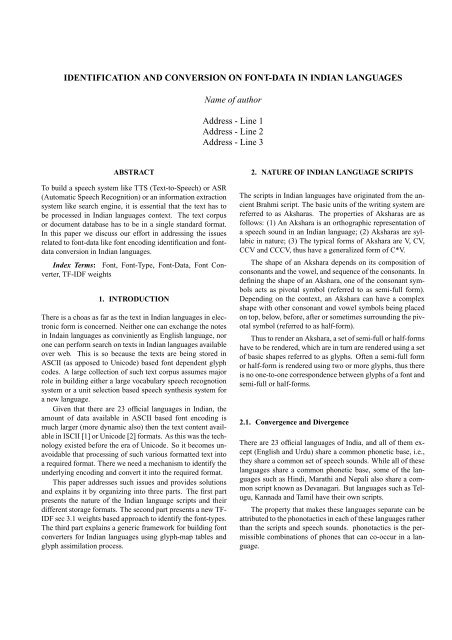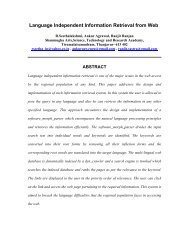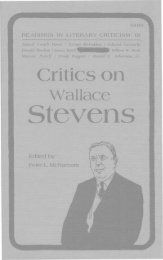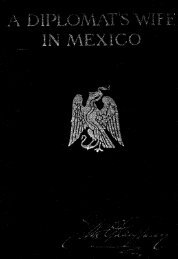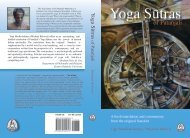IDENTIFICATION AND CONVERSION ON FONT-DATA IN INDIAN ...
IDENTIFICATION AND CONVERSION ON FONT-DATA IN INDIAN ...
IDENTIFICATION AND CONVERSION ON FONT-DATA IN INDIAN ...
Create successful ePaper yourself
Turn your PDF publications into a flip-book with our unique Google optimized e-Paper software.
<strong>IDENTIFICATI<strong>ON</strong></strong> <strong>AND</strong> <strong>C<strong>ON</strong>VERSI<strong>ON</strong></strong> <strong>ON</strong> F<strong>ON</strong>T-<strong>DATA</strong> <strong>IN</strong> <strong>IN</strong>DIAN LANGUAGESName of authorAddress - Line 1Address - Line 2Address - Line 3ABSTRACTTo build a speech system like TTS (Text-to-Speech) or ASR(Automatic Speech Recognition) or an information extractionsystem like search engine, it is essential that the text has tobe processed in Indian languages context. The text corpusor document database has to be in a single standard format.In this paper we discuss our effort in addressing the issuesrelated to font-data like font encoding identification and fontdataconversion in Indian languages.Index Terms: Font, Font-Type, Font-Data, Font Converter,TF-IDF weights1. <strong>IN</strong>TRODUCTI<strong>ON</strong>There is a choas as far as the text in Indian languages in electronicform is concerned. Neither one can exchange the notesin Indain languages as conviniently as English language, norone can perform search on texts in Indian languages availableover web. This is so because the texts are being stored inASCII (as apposed to Unicode) based font dependent glyphcodes. A large collection of such text corpus assumes majorrole in building either a large vocabulary speech recognotionsystem or a unit selection based speech synthesis system fora new language.Given that there are 23 official languages in Indian, theamount of data available in ASCII based font encoding ismuch larger (more dynamic also) then the text content availablein ISCII [1] or Unicode [2] formats. As this was the technologyexisted before the era of Unicode. So it becomes unavoidablethat processing of such various formatted text intoa required format. There we need a mechanism to identify theunderlying encoding and convert it into the required format.This paper addresses such issues and provides solutionsand explains it by organizing into three parts. The first partpresents the nature of the Indian language scripts and theirdifferent storage formats. The second part presents a new TF-IDF sec 3.1 weights based approach to identify the font-types.The third part explains a generic framework for building fontconverters for Indian languages using glyph-map tables andglyph assimilation process.2. NATURE OF <strong>IN</strong>DIAN LANGUAGE SCRIPTSThe scripts in Indian languages have originated from the ancientBrahmi script. The basic units of the writing system arereferred to as Aksharas. The properties of Aksharas are asfollows: (1) An Akshara is an orthographic representation ofa speech sound in an Indian language; (2) Aksharas are syllabicin nature; (3) The typical forms of Akshara are V, CV,CCV and CCCV, thus have a generalized form of C*V.The shape of an Akshara depends on its composition ofconsonants and the vowel, and sequence of the consonants. Indefining the shape of an Akshara, one of the consonant symbolsacts as pivotal symbol (referred to as semi-full form).Depending on the context, an Akshara can have a complexshape with other consonant and vowel symbols being placedon top, below, before, after or sometimes surrounding the pivotalsymbol (referred to as half-form).Thus to render an Akshara, a set of semi-full or half-formshave to be rendered, which are in turn are rendered using a setof basic shapes referred to as glyphs. Often a semi-full formor half-form is rendered using two or more glyphs, thus thereis no one-to-one correspondence between glyphs of a font andsemi-full or half-forms.2.1. Convergence and DivergenceThere are 23 official languages of India, and all of them except(English and Urdu) share a common phonetic base, i.e.,they share a common set of speech sounds. While all of theselanguages share a common phonetic base, some of the languagessuch as Hindi, Marathi and Nepali also share a commonscript known as Devanagari. But languages such as Telugu,Kannada and Tamil have their own scripts.The property that makes these languages separate can beattributed to the phonotactics in each of these languages ratherthan the scripts and speech sounds. phonotactics is the permissiblecombinations of phones that can co-occur in a language.
2.2. Digital Storage of Indian Language ScriptAnother aspect of diversion of electronic content of Indianlanguages is their format of digital storage. Storage formatslike ASCII (American Standard Code for Information Interchange)based fonts, ISCII (Indian Standard code for InformationInterchange) and Unicode are often used to store thedigital text data in Indian languages. The text is rendered usingsome fonts of these formats.2.3. ASCII FormatASCII is a character encoding based on the English alphabets.ASCII specifies a correspondence between digital bitpatterns and the symbols/glyphs of a written language. ASCIIis, strictly, a seven bit code so ranges from 0 to 255. ASCIIreserves the first 32 codes (numbers 0-31 decimal) for controlcharacters. Code 32, the ”space” character, denotes the spacebetween words. Codes 33 to 126, known as the printablecharacters, represent letters, digits, punctuation marks, and afew miscellaneous symbols. Text editors and word processorsare usually capable of storing data in ASCII format, althoughASCII format is not always the default storage format.2.4. Unicode Format[2] Two individual and independent project ISO 10646project of ISO (International Organization for Standardization),and Unicode project by manufacturers of multi-lingualsoftware were launched in late 80s in order to create a singleunified character set. But from 1991, they united in favor ofworld need and published their own tables. But they madethem compatible and agreed to perform any future extensionwith coordination. All Unicode versions since 2.0 arecompatible, only new characters will be added; no existingcharacters will be removed or renamed in the future. Computersstore everything by assigning a number to it because itcan store two bit 0 and 1. Unicode provides a unique numberfor every character, no matter what the platform, program orlanguage. Unicode is the universal character encoding, maintainedby the Unicode Consortium. This encoding standardprovides the basis for processing, storage and interchange oftext data in any language in all modern software and informationtechnology protocols. Unicode covers all the modernand ancient characters, technical symbols, punctuations, andmany other characters used in writing text for all the writingsystems of the world. Unicode enables a single softwareproduct or a single website to be targeted across multipleplatforms, languages and countries without re-engineering. Itallows data to be transported through many different systemswithout corruption.UTF: [3] A Universal Transformation Format (UTF) isan algorithmic mapping from every Unicode code point (exceptsurrogate code points) to a unique byte sequence. Actualimplementations in computer systems represent integersin specific code units of particular size (8 bit, 16 bit, or 32 bit).Encoding forms specify how each integer (code point) for aUnicode character is to be expressed as a sequence of oneor more code units. There are many Unicode TransformationFormats for encoding Unicode like UTF-8, UTF-16 and UTF-32. Both UTF-8 and UTF-16 are substantially more compactthan UTF-32, when averaging over the world’s text in computers.Conversion between different UTFs is very fast.2.5. ISCII Format[1] In India since 1970s, different committees of the Departmentof Official Languages and the Department of Electronics(DOE) have been developing different character encodingsschemes, which would cater to all the Indian scripts.In July 1983, the DOE announced the 7-bit ISCII-83 code ,which complied with the ISO 8-bit recommendations. Therewas a revision of the ISCII code by the DOE in 1988. Bureauof Standards (BIS) adopted ISCII-88 with minor revisionin 1991 and remains the prevalent national standard today[ISCII- 91 or IS13194:1991]. ISCII (Indian Script Codefor Information Interchange) is a fixed-length 8-bit encoding.The lower 128(0-127) code points are plain ASCII and theupper 95(160-255) code points are ISCII-specific, which isused for all Indian Script based on Brahmi script. This makesit possible to use an Indian Script along with latin script in an8-bit environment. This facilitates 8-bit bi-lingual representationwith Indic Script selection code. The ISCII code containsthe basic alphabet required by the Indian Scripts. All compositecharacters are formed by combining these basic characters.Unicode is based on ISCII-1988 and incorporates minor revisionsof ISCII-1991, thus conversion between one to anotheris possible without loss of information.2.6. Fonts and GlyphsPeople interpret the meaning of a sentence by the shapesof the characters contained in it. Reduced to the characterlevel, people consider the information content of a characterinseparable from its printed image. Information technology,in contrast, makes a distinction between the concepts of acharacter’s meaning (the information content) and its shape(the presentation image). Information technology uses theterm ”character” (or ”coded character”) for the informationcontent; and the term ”glyph” for the presentation image.A conflict exists because people consider ”characters” and”glyphs” equivalent. Moreover, this conflict has led to misunderstandingand confusion. This Technical Report [4] providesand expalins a framework for relating ”characters” and”glyphs” to resolve the conflict because successful processingand printing of character information on computers requiresan understanding of the appropriate use of ”characters” and”glyphs”. It defines them as follow:Character: A member of a set of elements used for theorganisation, control, or representation of data. (ISO/IEC
10646-1: 1993)Coded Character Set: A set of unambiguous rules thatestablishes a character set and the relationship between thecharacters of the set and their coded representation. (ISO/IEC10646-1: 1993)Font: A collection of glyph images having the same basicdesign, e.g., Courier Bold Oblique. (ISO/IEC 9541-1: 1991)Glyph: A recognizable abstract graphic symbol which isindependent of any specific design. (ISO/IEC 9541-1: 1991).Indian language electronic contents are scripted digitallyusing fonts. A font is a set of glyphs (images or shapes) representingthe characters from a particular character set in aparticular typeface. Glyphs do not correspond one-for-onewith characters. A font is or may be a discrete commoditywith legal restrictions.2.7. Need for Handling Font-DataIn the case of Indian languages, the text which is availablein digital format (on the web) is difficult to use as it is becausethey are available in numerous encoding (fonts) basedformats. Applications developed for Indian languages have toread or process such text. The glyphs are shapes, and when2 or more glyphs are combined together form a character inthe scripts of Indian languages. To view the websites hostingthe content in a particular font-type then one requiresthese fonts to be installed on local machine. As this wasthe technology existed before the era of Unicode and hencea lot of electronic data in Indian languages were made andavailable in that form. The sources for these data are Newswebsites (mainly), Universities/Institutes and some other organizations.They are using proprietary fonts to protect theirdata. Collection of these text corpora, identifying the type ofencoding or font and conversion to font-data into a phoneticallyreadable transliteration scheme is essential for buildingspeech recognition and speech synthesis systems.A character of English language has the same code irrespectiveof the font being used to display it. However, mostIndian language fonts assign different codes to the same character.For example ’a’ has the same numerical code ’97’ irrespectiveof the hardware or software platform.Consider for example the word ”hello” written in the RomanScript and the Devanagari Script.Fig. 1. Illustration of glyph code mapping for English fonts.Arial and Times New Roman are used to display the sameword. The underlying codes for the individual characters,however, are the same and according to the ASCII standard.Fig. 2. Illustration of glyph code mapping for Hnidi fonts.The same word displayed in two different fonts in Devanagari,Yogesh and Jagran. The underlying codes for theindividual characters are according to the glyphs they are brokeninto. Not only the decomposition of glyphs and the codesassigned to them are both different but even the two fonts havedifferent codes for the same characters. This leads to difficultiesin processing or exchanging texts in these formats.Three major reasons which cause this problem are, (i)There is no standard which defines the number of glyphs perlanguage hence it diferes between fonts of a specific languageitself. (ii) Also there is no standard which defines the mappingof a glyph to a number (code value) in a language. (iii)There is no standard procedure to align the glyphs while rendering.The common glyph alignment order followed is firstleft glyph, then pivotal character and then top or right or bottomglyph. Some font based scripting and rendering is violatingthis order also.2.8. A Phonetic Transliteration Scheme for Storage of IndianLanguage ScriptsTo handle diversified storage formats of scripts of Indian languagessuch as ASCII based fonts, ISCII (Indian Standardcode for Information Interchange) and Unicode etc, it is usefuland becomes necessary to use a meta-storage format.A transliteration scheme [5] [6] maps the Aksharas of Indianlanguages onto English alphabets and it could serve asmetastorage format for text-data. Since Aksharas in Indianlanguages are orthographic represent of speech sound, andthey have a common phonetic base, it is suggested to havea phonetic transliteration scheme such as IT3. Thus when thefont-data is converted into IT3, it essentially turns the wholeeffort into font-to-Akshara conversion.3. <strong>IDENTIFICATI<strong>ON</strong></strong> OF F<strong>ON</strong>T-TYPEThe widespread and increasing availability of textual data inelectronic form in various font encoded form in Indian languagesincreases the importance of using automatic methodsto analyze the content of the textual documents. The identificationand classification of the text or text documents basedon their content to a specific encoding type (specially font)are becoming imperative. Previous works [7] [8] [9] weredone to identify the language and later to identify the encodingsalso. Most of them N-gram based modeling technique.It may be helpful to make the difference clear here, the term
efers a ’glyph’ and the document refers the ’font-data (wordsand sentences) in a specific font-type’. The Term Frequency- Inverse Document Frequency (TF-IDF) approach is used toweigh each term in the document according to how uniqueit is. In other words, the TF-IDF approach captures the relevancyamong glyph-sequence, font-data and font type. It maybe helpful to make the difference clear here, the term refersa ’glyph’ and the document refers the ’font-data (words andsentences) in a specific font-type’. Here the glyph-sequencemeans unigram (single glyph), bigram (”current and next”glyph) and trigram (”previous, current and next” glyph) etc.3.1. TF-IDF (Term Frequency - Inverse Document Frequency)WeightsThe TF-IDF weight is a weight often used in information retrievaland text mining. This weight is a statistical measureused to evaluate how important a word is to a document in acollection or corpus. The importance increases proportionallyto the number of times a word appears in the document.The term frequency in the given document is simply thenumber of times a given term appears in that document. Thiscount is usually normalized to prevent a bias towards longerdocuments (which may have a higher term frequency regardlessof the actual importance of that term in the document)to give a measure of the importance of the term t i within theparticular document.tf i =n i∑k n (1)kwith n i being the number of occurrences of the consideredterm, and the denominator is the number of occurrences of allterms.The document frequency is the number of documentswhere the considered term has occurred at least once.|{d : d ∋ t i }| (2)The inverse document frequency is a measure of the generalimportance of the term (it is the logarithm of the numberof all documents divided by the number of documents containingthe term).|D|idf i = log(3)|{d : d ∋ t i }|with |D| total number of documents in the corpusThe effect of ’log’ in this formula is smoothing one.|{d : d ∋ t i }| : Number of documents where the term tiappears (that is n i ≠ 0) Thentfidf = tf.idf (4)A high weight in TF-IDF is reached by a high termfrequency (in the given document) and a low document frequencyof the term in the whole collection of documents; theweights hence tend to filter out common terms.3.2. Modeling and IdentificationData Preparation: For training we need sufficiently enoughdata of that particular type. And here we have collected andused more than 0.12 million unique words per font-type. it iscollected and prepared manually. We tried nearly 10 differentfonts of 4 languages.Modeling: Generating a statistical model for each fonttypeusing these TF-IDF weights is known as modeling thedata. For modeling we considered three different types ofterms. They are (i) unigram (single term), (ii) bigram (currentand next terms) and (iii) trigram (previous, current and nextterms). In raw text modeling the term refers the glyph basedunigram or bigram or trigram.The procedure for building the models is: First we havetaken all the provided data at once. And also we have consideredthree different kinds of terms for building models. (i)First step is to calculate the term frequency Eqn (1) for theterm like the number of time that term has occurred dividedby the total number of terms in that specific type of data. Soit will be stored in a matrix format of N ∗ 256 for unigram, N∗ 256 ∗ 256 for bigram and N ∗ 256 ∗ 256 ∗ 256 for trigrammodel depending upon the term. Where ’N’ denotes the numberof different data types and 256 (0 to 255) is the maximumnumber value for a single glyph or the the total number ofphones or syllables. (ii) Second step is to calculate documentfrequency Eqn (2) like in how many different data type thatspecific term has occurred. (iii) Third step is to calculate inversedocument frequency Eqn (3) like all data types dividedby the document frequency. Logarithm of inverse documentfrequency is taken for smoothing purpose. (iv) Fourth step isto compute TF-IDF which is calculated like term frequency *inverse document frequency Eqn (4). Finally that matrix willbe updated with these values. The common terms get zerovalues and other terms get non-zero values depending upontheir term frequency values. From those values the modelsfor each data type is generated.Identification: While identifying the language or encodingtype (font encoding name) first generate the terms (likeunigram, bigram and trigram) of the data type under consideration.Get the TF-IDF weight of each term from the modelsand calculate the summation. The maximum of all summationswill give the specific encoding type interms of the modelof the data type itself.3.3. Performance AnalysisTest Data: Two types of data were prepared for testing. Oneis ’N’ number of unique words and the other one is ’M’ numberof sentences. Where ’N’ is greater than ’M’ because theknowledge we got from our experiments says that when thenumber of terms in the test data increases it increases the identificationaccuracy. the value for ’N’ and ’M’ varies from experimentto experiment.
has been designed for building font converters for Indian languagesbased on this idea using glyph assimilation rules. Thefont conversion process has two phases, in the first phase weare building the Glyph-Map table for each font-type and in thesecond phase defining and modifying the glyph assimilationrules for a specific language.4.1. Exploiting Shape and Place InformationAs we have seen already in sec 2, the natural shape of a vowelor consonant gets changed when they become half or maatra.These symbols get attached in different places (top, bottom,left and right) while forming an akshara. The akshara is renderedand distinguished based upon where these symbols getattached with the pivotal character. We exploited these twoinformation in our approach for building the glyph-map tablefor a font-type.Following figures depict the position number assignmentto glyphs. First figure 3 shows the position number assignmentfor dependent vowel or maatra glyphs and second figure4 shows the position number assignment for consonantglyphs.Fig. 4. Assigning position numbers for consonants.Fig 4 shows consonant ”ka” is assigned no position numbersince it is full, consonant ”k1” is assigned a position number1 since it is a half consonant and consonant ”r2” is assigned aposition number 2 since it occurs left side of a pivotal character.4.2. Building Glyph-Map TableFig. 3. Assigning position numbers for vowels or maatras.Independent vowels are assigned ’0’ or nothing as positionnumber. All the dependent vowels known as ”Maatras”occur at left or right or top or bottom side of a pivotal character(vowel). So they get attached a positional numbers like 2(left), 3 (right), 4 (top) and 5 (bottom) always. This is commonacross all Indian languages. Fig 3 shows, vowel ”a” isassigned no position number and ”i” maatra is assigned positionnumber 2 since it occurs always left side of a pivotalcharacter.Most of the consonants will be either full or half and occurat center. So accordingly they are assigned 0 or 1 as positionalnumber. Some of the half consonants also occur rarely at theleft, right, top and bottom of a full character. They are all assigneda positional number like 2 (left), 3 (right), 4 (top) and5 (bottom) according to their place. But these are specific tosome Indian languages not common for all Indian languages.Glyph-Map table is a map table which gives a mapping betweenthe glyph code (0 to 255) to a phonetic notation. Thistable gives us the basic mapping between the glyph coding ofthe font-type to a notation of a transliteration scheme. As anovelty in our approach we have attached some number alongwith the phonetic notation to indicate the place of occurrenceof that glyph in that akshara. The way the position numbersare assigned is ’0’ or nothing for a full character (ex: e, ka),’1’ for a half consonants (ex: k1, p1), ’2’ for glyphs occur atleft hand side of a pivotal character (ex: i2, r2), ’3’ for glyphsoccur at right hand side of a pivotal character (ex: au3, y3),’4’ for glyphs occur at top of a pivotal character (ex: ai4, r4)and ’5’ for glyphs occur at bottom of a pivotal character (ex:u5, t5).To illustrate it with some real font text we have given belowin the figure 5 the position numbers for glyphs. Glyphsoccur in different places or positions are grouped in differentcolors. We have covered vowel glyphs as well as consonantglyphs.The position numbers along with the phonetic notationhelp us to form well distinguished glyph assimilation rules,because when similar glyphs get attached in different positionsform different characters. For each and every font ina language the glyph-map table has to be prepared like that.That means the glyph-map table converts different font encodingto a meta data which is in a phonetic notation. It isobserved that when we do such glyph-mapping for three differentfonts of a language we have covered almost 96% ofpossible glyphs in a language.
4.4. Rules for Glyph AssimilationGlyph assimilation rules are defined by observing how thecharacters are being rendered by the rendering engine. Eachrule takes a combination of two or more glyphs in a certainorder and produces a valid character. Such way we have defineda set of rules for each level and for every language separately.Since they are written in the phonetic transliterationscheme (IT3) it is easily to understand by anybody. Theremay be some common rules across many languages and somespecific rules for a language also. The different rules undereach and every category are explained with some examplesbelow. These rules can be modified or redefined whenever itis required.Fig. 5. Examples for assigning position numbers for glyphs.4.3. Glyph Assimilation ProcessGlyph Assimilation is defined as the process of merging twoor more glyphs and forming a single valid character. In thisway the splitted up parts of a character get merged to revealthe original character again. This happens in many levels likeconsonant assimilation, maatra assimilation, vowel assimilationand consonant clustering and in an ordered way.The identification of different levels and ordering themare the another important thing we have done here. Broadlythey can be classified into four levels. They are language preprocessing,consonant assimilation, vowel assimilation andschwa deletion. under language preprocessing level, languagespecific modifcations like halant and nukta modifications arecarried out first. Because here afterwards there should notbe any more symbols but only valid character glyphs are allowed.The next step is to reconstruct the pivotal consonant inan akshara if there is. This can be done under three sublevelslike consonant assimilation, cansonant and vowel assimilationand consonants clustering. Then we can form the vowels fromthe left out glyphs. Finally we have to do the schwa deletionbecause when a consonant and maatra merge up the inherentvowel (schwa) has to be removed.This assimilation process has been observed across manyIndian languages and found that they follow certain order.The order is: (i) Modifier Modification, (ii) Language Preprocessing,(iii) Consonant Assimilation, (iv) Consonant-Vowel Assimilation, (v) Consonants Clustering, (vi) MaatraAssimilation, (vii) Vowel-Maatra Assimilation and (viii)Schwa Deletion. The concept is, revealing out the pivotalconsonant in an akshara first then the the vowels.(i) Modifier Modification is the process where the charactersget modified because of the language modifiers like viramaand nukta. Ex:(a) ka + virama = k1(b) ra + nuk = r’a (Hindi)(c) d’a + nuk = d-a (Hindi)(d) n: + virama = r1 (Telugu)(ii) Language Preprocessing steps deal with some languagespecific processing like Ex:(a) aa3 + i3 = ri (Tamil)(b) r4 (REF) moves in front of the previous first fullconsonant (Hindi)(c) i2 moves next to the next of first full consonant(Hindi)(d) r3 moves in front of the previous first full consonant(Kannada)(iii) Consonant Assimilation is known as getting merged twoor more consonant glyphs and forms a valid single consonantlike Ex:(a) d1 + h5 = dh1 (Telugu)(b) kh1 + aa3 = kha (Gujarati)(c) e + a4 = va (Kannada)(d) n: + u3 + a4 = y1 (Kannada)(e) e + a4 + u3 = ma (Telugu)(f) di + h5 = dhi (Telugu)(iv) Maatra Assimilation is known as getting merged two ormore maatra glyphs and forms a valid single maatra likeEx:(a) aa3 + e4 = o3 (Hindi)(b) e4 + ai5 = ai3 (Telugu)(c) e3 + ii3 = ei3 (Telugu)
(d) e2 + e2 = ai3 (Malayalam)(v) Consonant-Vowel Assimilation is known as getting mergedtwo or more consonant and vowel glyphs and forms avalid single consonant like Ex:(a) e + a4 + u5 = pu (Telugu)(b) e + h5 = ph1 (Malayalam)(c) vaa + uu3 = maa (Malayalam)(vi) Vowel-Maatra Assimilation is known as getting mergedtwo or more vowel and maatra glyphs and forms a validsingle vowel like Ex:(a) a + aa3 = aa (Hindi)(b) e + e2 = ai (Malayalam)(c) i + au3 = ii (Malayalam)(vii) Consonant Clustering in known as merging the halfconsonant which usually occurs at the bottom of a fullconsonant to that full consonant like Ex:(a) la + l5 = lla (Hindi)(b) r2 + p1 + a4 = pra (Telugu)(c) va + y3 = vya (Malayalam)(d) va + v3 = vva (Malayalam)(viii) The Schwa Deletion is deleting the inherent vowel ’a’from a full consonant in necessary places like Ex:(a) ka + ii3 = kii(b) ma + virama = m15. PERFORMANCE ANALYSISData Preparation: In the phase of training, ’N’ different setsof words were prepared for each iteration. For testing 500unique words were prepared.Training: At first we build a simple converter with minimalrules. Then we pass the first set of words and get theoutput. Then we will ask the native speaker (or a linguist) toevaluate the output. He/she will provide the evaluation besidesthe correction for the wrongly converted words. Basedon that we will define new rules or modify the existing rules.Then we will pass the next set of words and we will collectthe feedabck and modify the rules. This process will be continuedfor many iterations untill we reach less or 0 conversionerrors. Then the whole process is repeated for a new font ofthat language. At leat we need to do this training for threedifferent fonts of a language. At end of this training processwe will be having the converter for that language.Testing: We pass a set of 500 words from a new font ofthat language to the already built font converter. Again weask the linguist to evaluate the output. We considered this iswhat the performance acuuracy of that fon converter.Evaluation: We have taken 500 unique words per fonttypeand generated the conversion output. The evaluationsresults (table 4) show that the font converter performs consistentlyeven for a new font-type. So it is only sufficient toprovide the Glyph-Map table for a new font-type to get a goodconversion results. In the case of Telugu, the number of differentglyphs and their possible combinations are huge thanother languages. Also it is common that the pivotal characterglyph comes first and other supporting glyphs come nextin the script. Whereas in Telugu some times the supportingglyphs come before the pivotal glyph which creates ambiguityin forming assimilation rules. Hence the converter performedlower than other converters. The conversion resultsare tabulated below.6. C<strong>ON</strong>CLUSI<strong>ON</strong>This paper explained the nature and difficulties associatedwith font-data processing in Indian languages. We have discussedthe new TF-IDF weights based approach for font identification.We have expalined a framework to build font convertersfor font-data conversion from glyph-to-grapheme usingglyph asssimilation process. We have also studied the performanceof the font identification for various cases. We havealso demonstrated the effectivenes of our approach for fontdataconversion to be as high as 99% on 9 Indian langaugesand for 34 different font-types.7. REFERENCES[1] ISCII, “ISCII - Indian Standard Code for InformationInterchange,” .[2] Unicode Consortium, “Unicode - Universal Code Standard,”.[3] UTF, “UTF - Unicode Transformation Form,” .[4] ISO/IEC JTC1/SC18/WG8, “Document processingand related communication - document description andprocessing languages,” 1997.[5] G. Madhavi, M. Balakrishnan, N. Balakrishnan, andR. Reddy, “Om: One tool for many (indian) languages,”Journal of Zhejiang University Science, 2005.[6] P. Lavanya, P. Kishore, and G. Madhavi, “A simple approachfor building transliteration editors for indian languages,”Journal of Zhejiang University Science, 2005.[7] K. Beesley, “Language identifier: A computer programfor automatic natural-language identification on on-linetext,” 1988.[8] William B., Cavnar, and John M. Trenkle, “N-grambasedtext categorization,” in Proceedings of SDAIR-94, 3rd Annual Symposium on Document Analysis and
Information Retrieval, Las Vegas, US, 1994, pp. 161–175.[9] Anil Kumar Singh, “Study of some distance measuresfor language and encoding identification,” in Proceedingsof the Workshop on Linguistic Distances, Sydney,Australia, July 2006, pp. 63–72, Association for ComputationalLinguistics.Table 4. Font conversion Performance.Training/Language Font Name Testing PerformanceHindi Amarujala Training 99.2%Jagran Training 99.4%Naidunia Training 99.8%Webdunia Training 99.4%Chanakya Testing 99.8%Marathi Shree Pudhari Training 100%Shree Dev Training 99.8%TTYogesh Training 99.6%Shusha Testing 99.6%Telugu Eenadu Training 93%Vaarttha Training 92%Hemalatha Training 93%TeluguFont Testing 94%Tamil Elango Valluvan Training 100%Shree Tam Training 99.6%Elango Panchali Training 99.8%Tboomis Testing 100%Kannada Shree Kan Training 99.8%TTNandi Training 99.4%BRH Kannada Training 99.6%BRH Vijay Testing 99.6%Malayalam Revathi Training 100%Karthika Training 99.4%Thoolika Training 99.8%Shree Mal Testing 99.6%Gujarati Krishna Training 99.6%Krishnaweb Training 99.4%Gopika Training 99.2%Divaya Testing 99.4%Punjabi DrChatrikWeb Training 99.8%Satluj Training 100%99.9%Bengali ShreeBan Training 97.5%hPrPfPO1 Training 98%Aajkaal Training 96.5%[10] Bharati Akshar, Nisha Sangal, Vineet Chaitanya,Amba P. Kulkarni, and Rajeev Sangal, “Generating convertersbetween fonts semi-automatically,” in SAARCconference on Multi-lingual and Multi-media InformationTechnology, 1998.[11] Garg Himanshu, “Overcoming the font and script barriersamong indian languages,” 2005.[12] S. Khudanpur and C. Schafer, “Devanagari converters,”.


